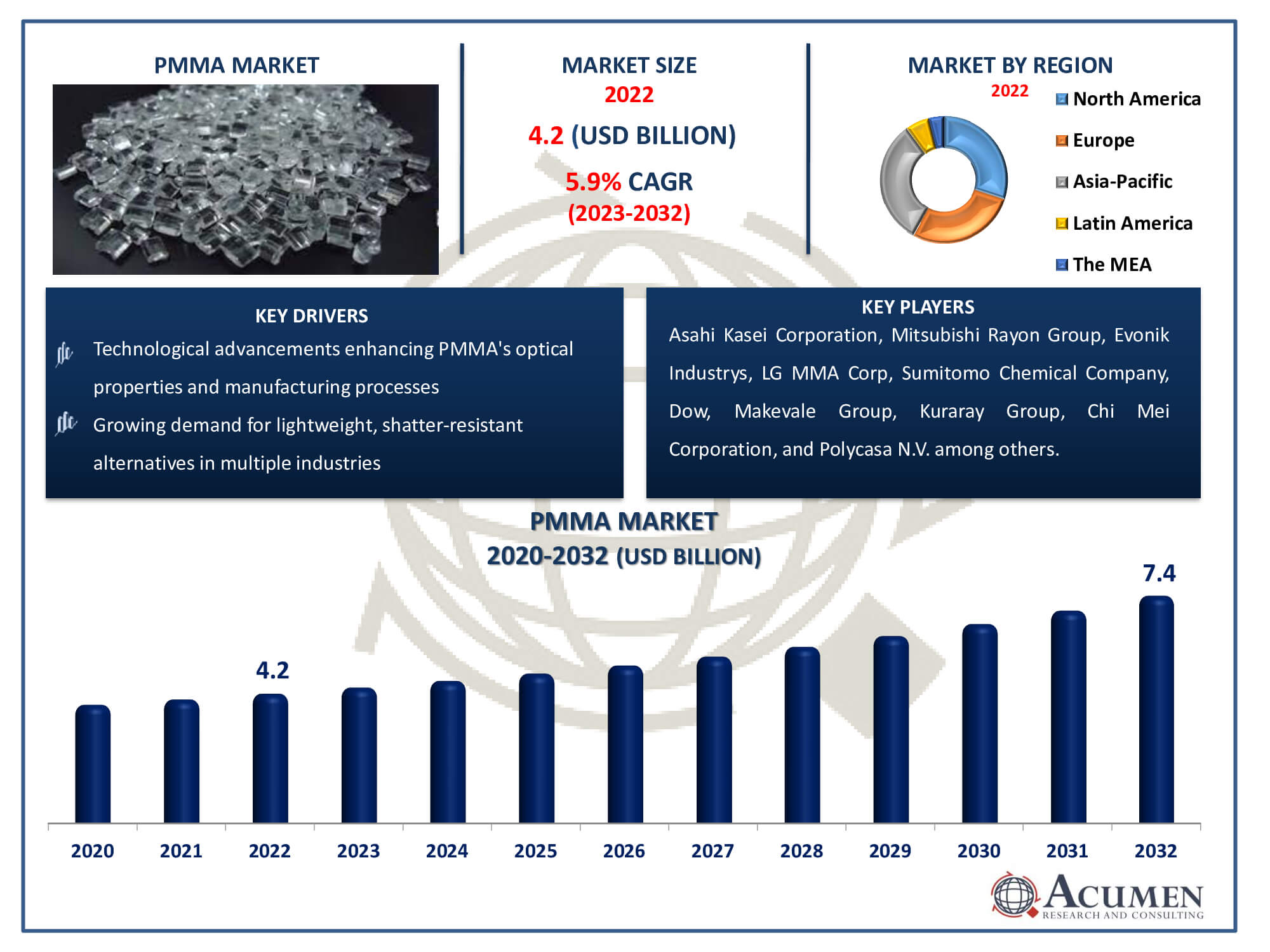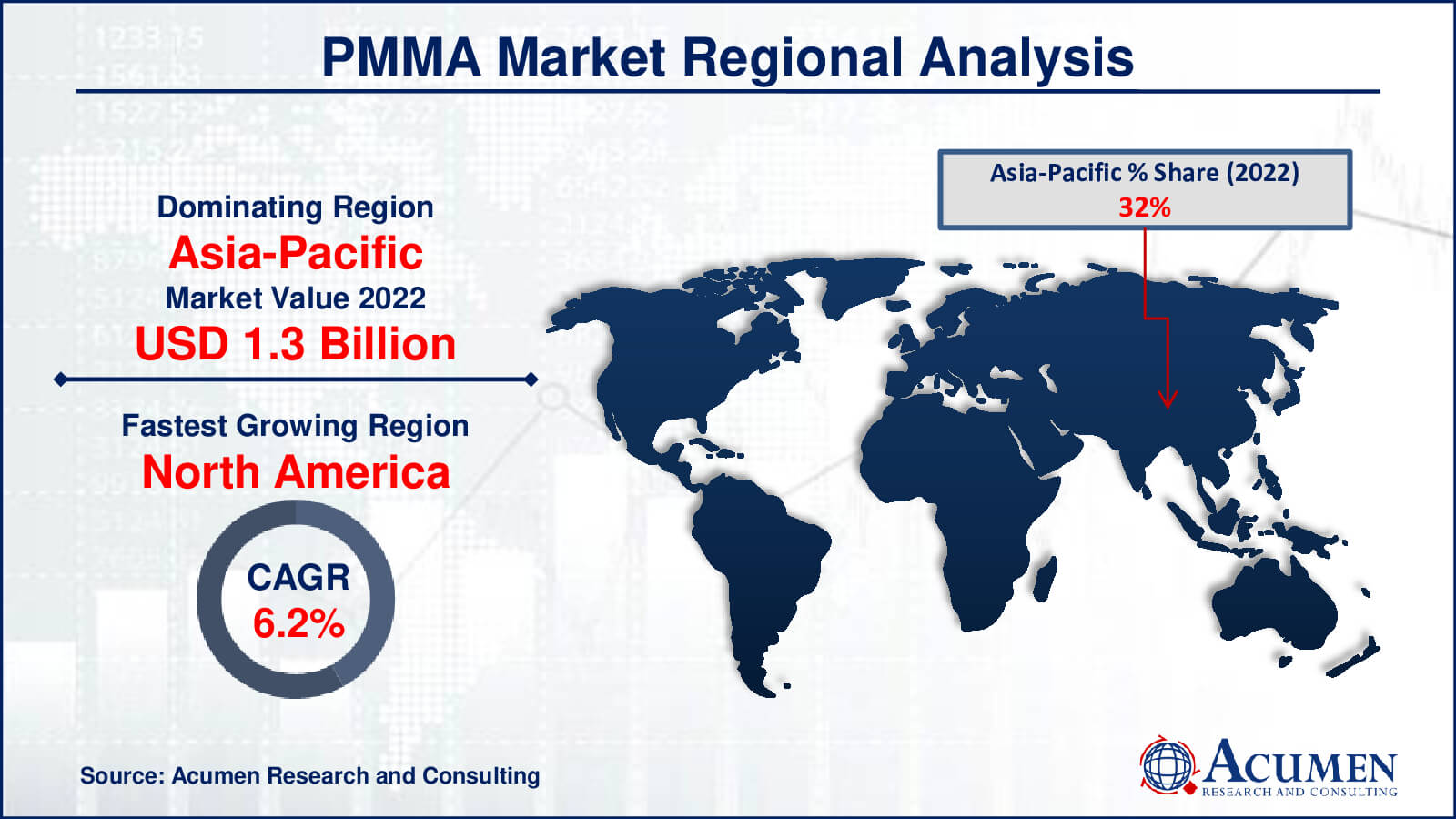Polymethyl Methacrylate Market Size - Global Industry, Share, Analysis, Trends and Forecast 2023 - 2032
Published :
Report ID:
Pages :
Format :
Polymethyl Methacrylate Market Size - Global Industry, Share, Analysis, Trends and Forecast 2023 - 2032
Report Coverage
- Industry Dynamics
- Market Size and Forecast Data
- Segment Analysis
- Competitive Landscape
- Regional Analysis with a Niche Focus on Country-Level Data
- High Level Analysis - Porter's, PESTEL, Value Chain, etc.
- Company Profiles of Key Players
- Option to Customize the Report As Per Your Specific Need
Request Sample Report
The Polymethyl Methacrylate (PMMA) Market Size accounted for USD 4.2 Billion in 2022 and is estimated to achieve a market size of USD 7.4 Billion by 2032 growing at a CAGR of 5.9% from 2023 to 2032.
Polymethyl Methacrylate (PMMA) Market Highlights
- Global polymethyl methacrylate (PMMA) market revenue is poised to garner USD 7.4 billion by 2032 with a CAGR of 5.9% from 2023 to 2032
- Asia-Pacific polymethyl methacrylate (PMMA) market value occupied around USD 1.3 billion in 2022
- North America polymethyl methacrylate (PMMA) market growth will record a CAGR of more than 6.2% from 2023 to 2032
- Among product type, the extruded sheets sub-segment generated noteworthy revenue in 2022
- Based on grade, the general purpose grade sub-segment generated around 61% share in 2022
- Growing demand for sustainable packaging solutions is a popular polymethyl methacrylate market trend that fuels the industry demand

The polymethyl methacrylate (PMMA) market stands as one of the fastest-growing segments in the global plastics industry. Recognized by brand names such as Lucite, Acrylite, and Plexiglas, PMMA is a transparent thermoplastic synthesized through polymerization from methyl methacrylate monomers. Its exceptional optical clarity, remarkable scratch resistance, and UV stability drive its market expansion. Widely embraced across industries, PMMA serves as a lightweight, break-resistant substitute for glass, finding application in automotive parts, architectural glazing, medical devices, displays, and lighting fixtures. This versatile material's popularity in construction, automotive, electronics, healthcare, and signage industries fuels its growth, meeting the rising demand for durable and sustainable materials in various technical advancements and applications.
Global Polymethyl Methacrylate Market Dynamics
Market Drivers
- Growing demand for lightweight, shatter-resistant alternatives in multiple industries
- Technological advancements enhancing PMMA's optical properties and manufacturing processes
- Rising focus on sustainable and eco-friendly materials
- Increasing utilization in automotive and construction sectors
Market Restraints
- Volatility in raw material prices impacts PMMA manufacturing costs
- Stringent environmental regulations pose challenges in PMMA production processes
- Competition from alternative materials
Market Opportunities
- Expanding applications in healthcare and electronics industries
- Innovations in PMMA formulations catering
- Emerging markets and untapped regions
Polymethyl Methacrylate Market Report Coverage
| Market | Polymethyl Methacrylate Market |
| Polymethyl Methacrylate Market Size 2022 | USD 4.2 Billion |
| Polymethyl Methacrylate Market Forecast 2032 | USD 7.4 Billion |
| Polymethyl Methacrylate Market CAGR During 2023 - 2032 | 5.9% |
| Polymethyl Methacrylate Market Analysis Period | 2020 - 2032 |
| Polymethyl Methacrylate Market Base Year |
2022 |
| Polymethyl Methacrylate Market Forecast Data | 2023 - 2032 |
| Segments Covered | By Product Type, By Grade, By End Use, And By Geography |
| Regional Scope | North America, Europe, Asia Pacific, Latin America, and Middle East & Africa |
| Key Companies Profiled | Asahi Kasei Corporation, Mitsubishi Rayon Group, Evonik Industries, LG MMA Corp, Sumitomo Chemical Company Ltd., Dow Chemical Company, Makevale Group, Kuraray Group, Chi Mei Corporation, Polycasa N.V., Dymatic Chemicals, Inc., and HCS Group GmbH. |
| Report Coverage |
Market Trends, Drivers, Restraints, Competitive Analysis, Player Profiling, Covid-19 Analysis, Regulation Analysis |
Polymethyl Methacrylate (PMMA) Market Insights
Fast digitization led to an increased demand for PMMA in signs and displays, illumination and similar applications, and led to attractive advertising options in the retail sector. Due to its advantageous characteristics, which include high thermal and chemical resilience, durability, low emission of smoke and excellent abrasion resistance, it is used in several industries. Highlights, aircraft canopies and shatter-resistant windows use the product as a smash proof alternative to glass. It is almost 40% lighter and more rigid, tough and transparent than glass. The product also produces insignificant smoke during processing and complies with stringent production and emission criteria.
Sustainable polymers, backed by favorable government regulations, have been rapidly rising, and bio-based raw materials have emerged. It is an effective alternative to petroleum products and reduces energy consumption during industrial work up to 30 percent. Increasing investment in the development of renewable products also paves the way for new market opportunities. Manufacturing is based on multiple technologies such as emulsion polymers, polymerization of suspensions, and bulk polymerization. In recent years, the industry has seen many innovative technologies and large firms have engaged in extensive R&D to develop innovative products that meet the constantly changing needs of consumers.
Polymethyl Methacrylate (PMMA) Market Segmentation
The worldwide market for polymethyl methacrylate (PMMA) market is split based on product type, grade, end use, and geography.
PMMA Market By Product Types
- Extruded Sheets
- Cast Acrylic Sheets
- Beads
- Pellets
- Others
The dominant product segment, extruded sheets, held over 50% of the global volume share in 2022, driven by robust demand across various industries. These sheets excel in applications requiring complex forms and exceptional thickness tolerance. Moreover, their economic efficiency stems from cost-effective manufacturing techniques. Anticipated future growth over the polymethyl methacrylate (PMMA) industry forecast period is linked to the increasing use of acrylic beads, serving as a thermoplastic or coating texturing agent. Expected to grow at a rapid CAGR between 2023 and 2032, these beads also function as curable binders in sticks, resins, and composites. The rising demand for aquariums and structural panels presents promising opportunities in pellet and cast acrylic markets.
PMMA Market By Grades
- General Purpose Grade
- Optical Grade
According to the polymethyl methacrylate (PMMA) industry analysis, the market is dominated by the general purpose grade segment. general purpose grade PMMA is widely used in many different applications because of its adaptability, affordability, and simplicity of processing. This grade offers an affordable and high-performance solution for a variety of industries, including as construction, automotive, signage, and household items. Because it is used in applications with strict optical requirements, like lenses, displays, and high-precision optical components, optical grade PMMA, despite being notable for its exceptional optical clarity, tends to have a smaller market share than general purpose grade PMMA.
PMMA Market By End Uses
- Construction
- Automotive
- Signs & Displays
- Electronics
- Others
The PMMA market segments according to end-use encompass automotive, construction, electronics, signs, and displays. PMMA finds usage in lighting signs for publicity and directions due to its exceptional visible light transmission. It's also utilized in fiber optics, retaining reflected light within surfaces for telecom signs, displays, and endoscopy applications.
The automotive sector sees increased PMMA use for lightweight vehicle parts, aiming for fuel efficiency. Its high weathering and ultraviolet resistance, along with optimal acoustic properties, make it popular for automotive glazing.
PMMA tube materials and vacuum isolation panels cater to low-energy buildings. Casted acrylic and extruded sheets find favor in thermal isolation applications. Anticipated market growth, driven by increased building activities, especially in India, China, and Brazil, correlates with rising income levels and government support for construction projects.
PMMA Market Regional Outlook
North America
- U.S.
- Canada
Europe
- U.K.
- Germany
- France
- Spain
- Rest of Europe
Asia-Pacific
- India
- Japan
- China
- Australia
- South Korea
- Rest of Asia-Pacific
Latin America
- Brazil
- Mexico
- Rest of Latin America
The Middle East & Africa
- South Africa
- GCC Countries
- Rest of the Middle East & Africa (ME&A)

PMMA Market Regional Analysis
According to the polymethyl methacrylate (PMMA) market analysis In terms of revenues, the highest expected Compound Annual Growth Rate (CAGR) is projected for the Asia Pacific region over the forecast period. Anticipated increases in per capita income, particularly in countries like China and India, are poised to drive car sales and subsequently boost demand for the product. Additionally, there are numerous investment opportunities in this region, as multinational corporations relocate production bases to emerging economies. The second-largest consumer in the coming years is expected to be the North America.
The market dynamics are anticipated to be positively influenced by future projects and collaborations with major industry players in the region. Significant potential is also seen in emerging countries across Central and South America. Events such as the Rio Olympics in Brazil (2016) intensified the demand for signs and displays, while events like the CEGs in 2018 further contributed to industry growth in the area.
PMMA Market Players
Some of the top polymethyl methacrylate (PMMA) companies offered in our report includes Asahi Kasei Corporation, Mitsubishi Rayon Group, Evonik Industries, LG MMA Corp, Sumitomo Chemical Company Ltd., Dow Chemical Company, Makevale Group, Kuraray Group, Chi Mei Corporation, Polycasa N.V., Dymatic chemicals, Inc., and HCS Group GmbH.
Frequently Asked Questions
How big is the polymethyl methacrylate market?
The market size of polymethyl methacrylate (PMMA) was USD 4.2 Billion in 2022.
What is the CAGR of the global PMMA market from 2023 to 2032?
The CAGR of polymethyl methacrylate (PMMA) is 5.9% during the analysis period of 2023 to 2032.
Which are the key players in the PMMA market?
The key players operating in the global market are including Asahi Kasei Corporation, Mitsubishi Rayon Group, Evonik Industries, LG MMA Corp, Sumitomo Chemical Company Ltd., Dow Chemical Company, Makevale Group, Kuraray Group, Chi Mei Corporation, Polycasa N.V., Dymatic chemicals, Inc., and HCS Group GmbH.
Which region dominated the global polymethyl methacrylate (PMMA) market share?
Asia-Pacific held the dominating position in polymethyl methacrylate (PMMA) industry during the analysis period of 2023 to 2032.
Which region registered fastest CAGR from 2023 to 2032?
North America region exhibited fastest growing CAGR for market of polymethyl methacrylate (PMMA) during the analysis period of 2023 to 2032.
What are the current trends and dynamics in the global polymethyl methacrylate (PMMA) industry?
The current trends and dynamics in the polymethyl methacrylate (PMMA) industry include growing demand for lightweight, shatter-resistant alternatives in multiple industries, technological advancements enhancing PMMA's optical properties and manufacturing processes, rising focus on sustainable and eco-friendly materials, and increasing utilization in automotive and construction sectors.
Which product type held the maximum share in 2022?
The extruded sheets product type held the maximum share of the polymethyl methacrylate (PMMA) industry.?


